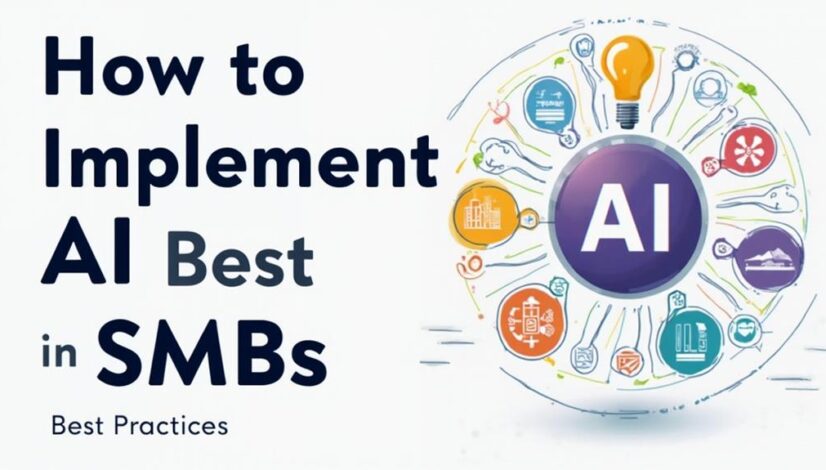How to Implement AI in SMBs: Best Practices
Implementing AI in small and medium-sized businesses (SMBs) requires a strategic approach. First, identify specific business needs and pain points to target areas for improvement. Choose AI tools that align with your budget and operational goals while ensuring they integrate seamlessly with existing systems. Develop a thorough implementation plan that involves all stakeholders and outlines clear timelines and responsibilities. Finally, establish performance metrics to track AI impact and continuously optimize its use. Successfully adopting AI can greatly improve efficiency and customer experience, making your business more competitive. There's much more to explore for effective implementation strategies.
Key Takeaways
- Identify specific business pain points and opportunities for improvement to effectively target AI solutions that drive efficiency and innovation.
- Choose user-friendly AI tools that align with your budget and existing systems to ensure seamless integration and high adoption rates.
- Develop a strategic implementation plan that includes stakeholder engagement, role assignments, and clear objectives for successful AI integration.
- Measure success through performance metrics, analyzing productivity improvements and gathering feedback to refine AI usage continuously.
- Foster a culture of agility, focusing on ongoing optimization of AI technologies to adapt to changing business conditions and user needs.
Understanding AI and Its Benefits

Artificial Intelligence (AI) represents a transformative force in the business landscape, particularly for small and medium-sized businesses (SMBs) aiming to enhance operational efficiency and maintain competitive advantage. Understanding AI fundamentals is essential for business leaders to distinguish between hype and genuine opportunity.
At its core, AI encompasses a variety of technologies, including machine learning, natural language processing, and computer vision, all designed to mimic human cognitive functions and automate decision-making.
The business impact of integrating AI into SMBs is profound. It enables organizations to streamline processes, improve customer interactions, and derive actionable insights from data. For instance, AI-driven analytics can uncover customer preferences, empowering businesses to tailor their offerings and enhance user experiences.
In addition, automation of routine tasks frees up valuable employee time, allowing staff to focus on strategic initiatives and innovation. This shift not only boosts productivity but also fosters a more dynamic workplace culture.
Furthermore, AI facilitates scalability, enabling SMBs to compete more effectively with larger entities. By leveraging AI solutions, these businesses can optimize resource allocation and adapt swiftly to market changes.
Importantly, as AI technology continues to evolve, the potential for disruptive innovation grows, encouraging SMBs to stay ahead of trends and invest wisely in their digital transformation journeys.
Assessing Business Needs
To effectively harness the advantages of AI, SMBs must first engage in a thorough assessment of their business needs. This vital step informs not only the direction of AI implementation but also guarantees alignment with the overall business strategy.
The first task involves identifying pain points within the organization. These may range from inefficiencies in customer service to delays in inventory management. Recognizing these challenges allows decision-makers to prioritize areas where AI can deliver the most significant impact.
Following the identification of pain points, the next step is evaluating current processes. This analysis provides an all-encompassing understanding of how existing workflows function, shedding light on bottlenecks and performance gaps. For instance, automating repetitive tasks can lead to improved productivity, allowing employees to focus on more strategic initiatives.
With clarity on pain points and process inefficiencies, SMBs can better ascertain where AI can serve as a transformative tool.
Moreover, this assessment should involve soliciting input from employees at all levels, as they possess valuable insights into the day-to-day operations that management may overlook. Engaging staff fosters a sense of ownership and encourages buy-in for AI initiatives.
Choosing the Right AI Tools

Selecting the appropriate AI tools is crucial for SMBs aiming to optimize their operations and gain a competitive edge. The right tools can streamline processes, enhance decision-making, and boost productivity, ultimately leading to increased profitability. However, with myriad options available, businesses must prioritize informed tool selection to guarantee alignment with their specific needs and objectives.
First and foremost, conducting a thorough vendor evaluation is critical. This process should include evaluating the vendor's reputation, customer support, and the scalability of their solutions. Understanding these factors will enable SMBs to choose tools that not only meet their current requirements but also have the potential for future growth. Additionally, an evaluation of the vendor's previous case studies or testimonials can provide insights into how their tools perform in a real-world environment.
Another key consideration in the tool selection process is the integration capabilities of AI tools with existing systems. Seamless integration guarantees that data flows efficiently across platforms, minimizing disruption and maximizing the return on investment.
Furthermore, businesses should analyze the user experience of potential tools; ease of use can greatly reduce the learning curve and boost employee adoption rates.
Ultimately, choosing the right AI tools is a strategic decision that can propel SMBs toward greater autonomy and innovation. By prioritizing rigorous vendor evaluation and thorough analysis in tool selection, businesses can harness the full potential of AI to not only meet operational challenges but also empower their growth trajectories.
Developing a Strategic Implementation Plan
Crafting a strategic implementation plan is essential for SMBs aiming to effectively integrate AI tools into their operations. This plan serves as a roadmap, guiding organizations through the complex journey of AI adoption and ensuring that the deployment aligns with their overarching business objectives.
A successful implementation plan begins with extensive stakeholder engagement. It is essential to involve key personnel from various departments early in the process, as their insights can illuminate potential challenges and benefits that may not be immediately apparent. Engaging stakeholders fosters a sense of ownership and commitment, which is vital for overcoming resistance and ensuring smooth integration.
Resource allocation is another important component of the strategic plan. SMBs often operate under tight budgets and constrained resources, making it imperative to allocate financial and human resources wisely. A well-defined budget should not only account for the upfront costs of AI tools but also consider training, maintenance, and potential scalability.
Additionally, prioritizing projects based on their projected ROI can help maximize the impact of resource investments.
Furthermore, the strategic plan should establish clear timelines and responsibility matrices. By defining who is accountable for each phase of the implementation, SMBs can streamline processes and maintain momentum. This level of organization not only facilitates timely execution but also enhances transparency, keeping all stakeholders informed and engaged as the organization shifts into an AI-driven future.
Ultimately, a robust strategic implementation plan serves as the backbone for successful AI integration, empowering SMBs to harness technology's full potential while fostering a culture of innovation.
Measuring Success and Optimizing Usage

The successful implementation of AI tools marks just the beginning of a broader journey for SMBs; ongoing evaluation and optimization are key to ensuring these technologies deliver maximum value over time. A systematic approach to measuring success involves developing specific performance metrics tailored to the unique objectives of the business. Metrics such as increased efficiency, cost reductions, and improved customer satisfaction can provide quantifiable benchmarks to assess the impact of AI initiatives.
Simultaneously, gathering user feedback is essential. Employees and customers are often the best sources of information regarding the practical implications of AI tools. Their insights can reveal usability issues, functionality gaps, or suggestions for enhancements, which can drive iterative improvements. Regular surveys or focus groups can facilitate this feedback loop, enabling businesses to adapt their strategies dynamically.
Furthermore, it is critical to establish a framework for continuous learning and evolution. AI technologies are not static; they evolve, as do market conditions and consumer expectations. By fostering a culture that embraces agility, SMBs can remain competitive and harness the full potential of AI.
Frequently Asked Questions
What Budget Should We Allocate for Implementing AI in Our Smb?
Determining an appropriate budget for implementing AI in a small to medium-sized business (SMB) necessitates a thorough AI cost estimation and ROI analysis.
Organizations should evaluate initial investment costs, ongoing maintenance, and potential scalability. Typically, allocating 5-10% of revenue for technology initiatives is prudent.
Additionally, projected returns, enhanced operational efficiency, and improved customer engagement justify this investment, fostering long-term growth and ensuring that the SMB remains competitive in an increasingly digital landscape.
How Can We Train Employees to Work With AI Tools Effectively?
Imagine a well-oiled machine where every employee harmoniously interacts with AI tools, driving innovation and efficiency.
To achieve this synergy, organizations must focus on employee engagement through tailored training resources. Providing thorough workshops, hands-on sessions, and continuous support fosters a culture of learning.
Regular feedback loops and incentives can further motivate employees to embrace these tools, ultimately releasing their full potential and enhancing overall productivity within the enterprise.
What Common Pitfalls Should We Avoid During AI Implementation?
During AI implementation, numerous pitfalls can hinder success. Avoiding inadequate resources, poor vendor selection, and lack of strategy is vital.
Establishing a clear roadmap counteracts unrealistic expectations and employee resistance. Furthermore, focus on data quality; incomplete or erroneous data yields unreliable outcomes.
Insufficient testing before deployment can lead to operational failures. Finally, effective change management practices are essential to facilitate smooth integration, enhancing both employee engagement and overall productivity within the organization.
How Do We Ensure Data Privacy and Security With Ai?
"An ounce of prevention is worth a pound of cure."
Ensuring data privacy and security with AI necessitates rigorous measures, including data encryption and stringent access controls. Obtaining user consent and adhering to compliance regulations are essential.
Conducting regular risk assessments and establishing thorough monitoring systems will aid in early identification of vulnerabilities.
Additionally, maintaining a robust incident response strategy and addressing ethical considerations will ultimately safeguard both data and user trust.
Can We Integrate AI With Existing Software Systems Seamlessly?
Seamless integration of AI with existing software systems presents notable software compatibility challenges that must be addressed through effective AI integration strategies.
Organizations need to evaluate current infrastructure and prioritize compatibility, utilizing APIs and modular solutions that facilitate interoperability.
Successful integration enhances operational efficiency while ensuring data integrity.
Conclusion
Incorporating artificial intelligence into small and medium-sized businesses is akin to planting a seed that nurtures future growth. By meticulously evaluating needs, selecting appropriate tools, and implementing a strategic plan, a robust ecosystem can flourish. Success measurement and optimization serve as essential watering techniques, ensuring continued development and adaptation. Embracing AI not only enhances operational efficiency but also positions businesses to navigate an increasingly competitive landscape, transforming potential into measurable outcomes.




